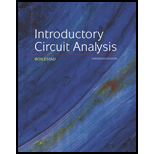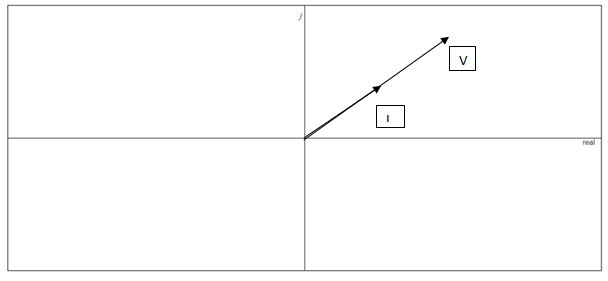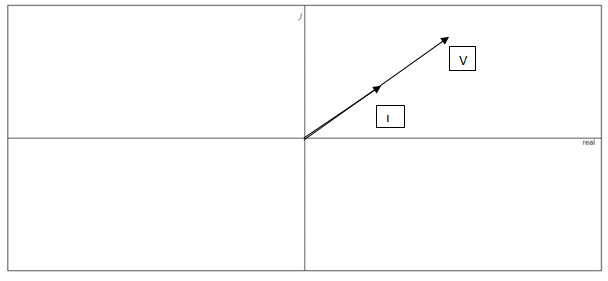
Concept explainers
For the resistive element in Fig. 15.81:
- Write the current in phasor form.
- Calculate the voltage across the resistor in phasor form.
- Sketch the phasor diagram of the voltage and current.
- Write the voltage in the sinusoidal format.
- Sketch the waveform of the voltage and current.

Fig. 15.81
(a)
The Current in phasor form.
Answer to Problem 1P
The current in phasor form is
Explanation of Solution
Given:
The sinusoidal expression of current is
The resistor value is
Concept Used:
In resistive element network, the network consists of only resistor element.
Resistor does not have any phase angle. It's purely real.
In this, the network current is in phase with voltage.
Total impedance
Current:
Calculation:
In order to convert to phasor form
Conclusion:
Hence, the current in phasor form is
(b)
Voltage across resistor in phasor form.
Answer to Problem 1P
Voltage across resistor in phasor form is
Explanation of Solution
Given:
The sinusoidal expression of current is
The resistor value is
Concept Used:
In resistive element network, the network consists of only resistor element.
Resistor does not have any phase angle. It's purely real.
In this network current are in phase with voltage.
Total impedance
Current:
Calculation:
We know that voltage across resistor is given by
Conclusion:
Hence, the voltage across resistor in phasor form is
(c)
Phasor diagram of the voltage and current.
Answer to Problem 1P
Phasor diagram of the voltage and current is drawn.

Explanation of Solution
Given:
The sinusoidal expression of current is
The resistor value is
Concept Used:
In resistive element network, the network consists of only resistor element.
Resistor does not have any phase angle. It's purely real.
In this, network current are in phase with voltage.
Total impedance
Current:
Calculation:
Based on the voltage and current value which is already obtained in above part the phasor diagram is drawn. From real axis the angle value is counted.

Conclusion:
Hence, the phasor diagram of the voltage and current is drawn.
(d)
Voltage in the sinusoidal expressions.
Answer to Problem 1P
Voltage in the sinusoidal expressions is
Explanation of Solution
Given:
The sinusoidal expression of current is
The resistor value is
Concept Used:
In resistive element network, the network consists of only resistor element.
Resistor does not have any phase angle. It's purely real.
In this, the network current is in phase with voltage.
Total impedance
Current:
Calculation:
In order to convert to sinusoidal form,
Conclusion:
Hence, voltage in the sinusoidal expressions is
(e)
Waveform of the voltage and current.
Answer to Problem 1P
Waveform of the voltage and current is drawn.

Explanation of Solution
Given:
The sinusoidal expression of current is
The resistor value is
Concept Used:
In resistive element network, the network consists of only resistor element.
Resistor does not have any phase angle. It's purely real.
In this, the network current is in phase with voltage.
Total impedance
Current:
Calculation:
Based on the voltage and current value which is already obtained in the above part, the waveform diagram is drawn. Here, A stands for amplitude.

Conclusion:
Hence, waveform of the voltage and current is drawn.
Want to see more full solutions like this?
Chapter 15 Solutions
Introductory Circuit Analysis (13th Edition)
Additional Engineering Textbook Solutions
Starting Out with Programming Logic and Design (5th Edition) (What's New in Computer Science)
Database Concepts (8th Edition)
Electric Circuits. (11th Edition)
Thermodynamics: An Engineering Approach
Modern Database Management
Automotive Technology: Principles, Diagnosis, And Service (6th Edition) (halderman Automotive Series)
- help on this question about power electronics?arrow_forwardA speech signal has frequencies in the range 50- 3500 Hz. The signal is sampled at Nyquist sampling rate and the resulting pulses are transmitted over PAM and PCM systems. 1- Calculate the minimum bandwidth of the PAM system. 2- Calculate the minimum bandwidth of the PCM system, when the pulses are quantized into 121 levels B) Draw the signaling waveform (line codes) for the binary sequence 10110001 using (Unipolar NRZ, Bipolar RZ, Bipolar NRZ, Manchester code, Differential Manchester (split phase).arrow_forwardDon't use ai to answer I will report you answerarrow_forward
- Don't use ai to answer I will report you answerarrow_forward8-1) similar to Lathi & Ding, Prob. P.5.1-2 The figure below shows the Fourier spectra of signals of g,(t) and g₁(t). Determine the Nyquist rate and the corresponding sampling interval for signals of g,(t), g,(t), g₁(1) - g¸(1), g¸³(t), and g₁(1)g₁(1). Hint: Use the frequency convolution and the width property of convolution. G₁(f) G₂(f) -8000 0 8000 f -20000 10 20000 farrow_forward• We will use the Wattmeter to find the average power supplied/absorbed by each component. The following figure shows how to connect the Wattmeter to measure the average power absorbed by the resistor. Note that the Wattmeter consists of a Voltmeter and an Ammeter. The Voltmeter must be connected in parallel with the component and the Ammeter must be connected in series with the component. You must pay attention to the polarity of the voltage across the component as well as the direction of the current flowing through the component. 5Vpk 1kHz 30° ww 40 Z=A-JB Wattmeter-XWM1 2.503 W Power factor: 1.00000 Voltage Current • • Similarly connect a second Wattmeter to measure the average power supplied by the source. Connect a third Wattmeter to measure the average power in the capacitor. Does this value agree with the theoretical value? Perform Interactive Simulation under Analysis and Simulation. Double click on Wattmeters to see the average power values. Note that the Wattmeter also…arrow_forward
 Power System Analysis and Design (MindTap Course ...Electrical EngineeringISBN:9781305632134Author:J. Duncan Glover, Thomas Overbye, Mulukutla S. SarmaPublisher:Cengage Learning
Power System Analysis and Design (MindTap Course ...Electrical EngineeringISBN:9781305632134Author:J. Duncan Glover, Thomas Overbye, Mulukutla S. SarmaPublisher:Cengage Learning
